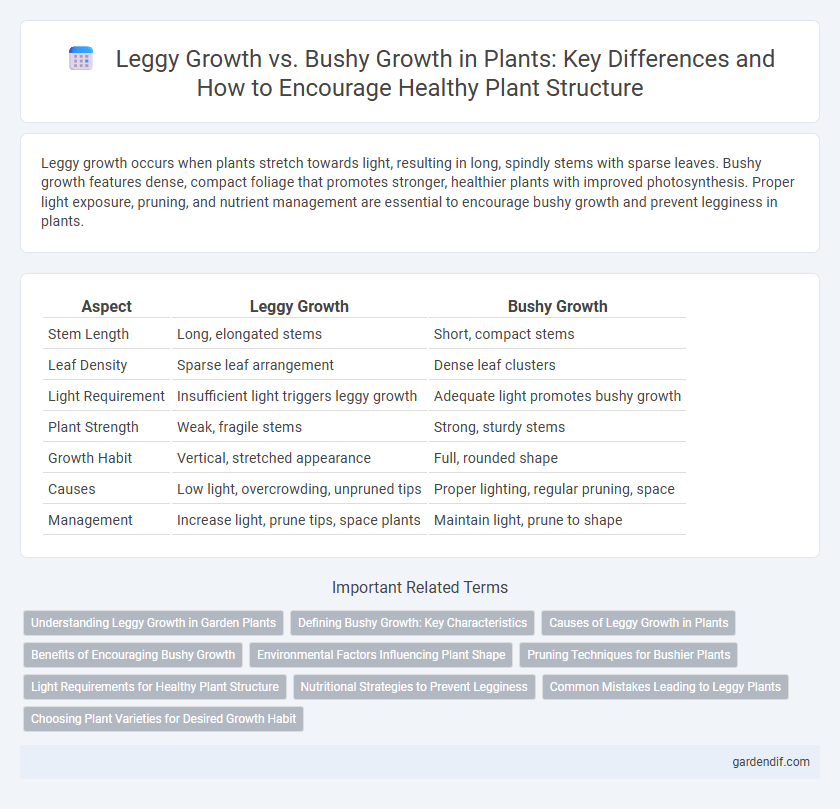
Leggy Growth vs Bushy Growth Illustration
Leggy growth occurs when plants stretch towards light, resulting in long, spindly stems with sparse leaves. Bushy growth features dense, compact foliage that promotes stronger, healthier plants with improved photosynthesis. Proper light exposure, pruning, and nutrient management are essential to encourage bushy growth and prevent legginess in plants.
Table of Comparison
| Aspect | Leggy Growth | Bushy Growth |
|---|---|---|
| Stem Length | Long, elongated stems | Short, compact stems |
| Leaf Density | Sparse leaf arrangement | Dense leaf clusters |
| Light Requirement | Insufficient light triggers leggy growth | Adequate light promotes bushy growth |
| Plant Strength | Weak, fragile stems | Strong, sturdy stems |
| Growth Habit | Vertical, stretched appearance | Full, rounded shape |
| Causes | Low light, overcrowding, unpruned tips | Proper lighting, regular pruning, space |
| Management | Increase light, prune tips, space plants | Maintain light, prune to shape |
Understanding Leggy Growth in Garden Plants
Leggy growth in garden plants occurs when stems become long, thin, and weak due to insufficient light, causing the plant to stretch towards the source. This often results in sparse foliage and reduced overall health, making plants more vulnerable to pests and diseases. Addressing light intensity and spacing can prevent legginess and promote robust, bushy growth with dense leaves.
Defining Bushy Growth: Key Characteristics
Bushy growth in plants is characterized by a dense, compact structure with multiple lateral branches that create a fuller appearance. This growth pattern results from healthy stem development and adequate light exposure, promoting a balanced distribution of leaves and foliage. Plants exhibiting bushy growth typically have stronger stems and enhanced photosynthetic capacity, contributing to overall vigor and productivity.
Causes of Leggy Growth in Plants
Leggy growth in plants is primarily caused by insufficient light, which forces stems to elongate as they reach toward a light source. Overcrowding of plants also contributes to leggy growth by increasing competition for light and nutrients. Furthermore, excessive nitrogen fertilization can promote rapid stem elongation without adequate leaf development, resulting in sparse, weak growth.
Benefits of Encouraging Bushy Growth
Encouraging bushy growth in plants results in a denser foliage structure that enhances photosynthesis efficiency and improves overall plant health. This growth pattern increases the number of lateral branches, which supports more flowers or fruit production, maximizing yield. Bushy plants also provide better ground coverage, reducing soil erosion and minimizing weed growth around the base.
Environmental Factors Influencing Plant Shape
Leggy growth in plants often results from inadequate light, leading stems to elongate as they stretch toward available light sources. In contrast, bushy growth is promoted by optimal light exposure, encouraging compact and dense foliage development. Factors such as light intensity, duration, and direction significantly influence plant morphology, determining whether a plant exhibits leggy or bushy characteristics.
Pruning Techniques for Bushier Plants
Pruning techniques such as pinching back the stem tips and selectively removing elongated shoots promote bushier growth by encouraging lateral branching in plants. Regularly trimming leggy growth prevents excess vertical elongation, redirecting energy towards developing denser foliage and a fuller plant structure. Using sharp, clean pruning tools and making precise cuts just above leaf nodes maximizes the effectiveness of pruning for vibrant, compact growth.
Light Requirements for Healthy Plant Structure
Leggy growth in plants often occurs due to insufficient light, causing stems to elongate excessively as the plant stretches toward the nearest light source. In contrast, bushy growth is promoted by ample, evenly distributed light, which encourages compact, dense foliage development. Proper light intensity and duration directly influence chlorophyll production and photosynthesis efficiency, essential for maintaining a healthy and balanced plant structure.
Nutritional Strategies to Prevent Legginess
Leggy growth in plants, characterized by elongated stems and sparse foliage, often results from insufficient light and nutrient imbalances. Optimizing nitrogen levels combined with adequate potassium and phosphorus supports robust, bushy growth by promoting strong stem development and leaf expansion. Regular application of balanced fertilizers, alongside supplemental micronutrients like calcium and magnesium, enhances plant vigor and prevents legginess effectively.
Common Mistakes Leading to Leggy Plants
Leggy growth in plants often results from insufficient light, causing elongated stems as the plant stretches toward the light source. Overcrowding and improper pruning can also contribute to sparse, weak branches instead of dense, bushy foliage. Ensuring adequate sunlight, proper spacing, and regular trimming helps prevent leggy growth and promotes healthy, compact plant development.
Choosing Plant Varieties for Desired Growth Habit
Selecting plant varieties with inherent bushy growth tendencies ensures a denser, more compact appearance ideal for ornamental gardens or privacy hedges. Plants naturally prone to leggy growth often require strategic pruning and optimal light conditions to encourage fuller development and prevent sparse, elongated stems. Understanding species-specific growth habits and their environmental needs supports effective landscape planning and achieves the desired plant structure.
Leggy Growth vs Bushy Growth Infographic

 gardendif.com
gardendif.com